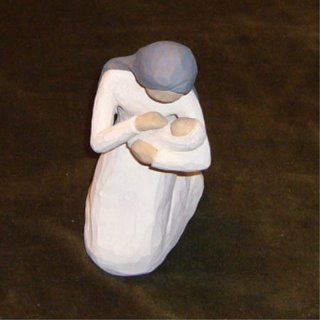I'm not sure why the picture wouldn't post on this, but it's in the post above now.Mormons aren't really devotees of all the dates on the Catholic calendar, but at this time of year I enjoy thinking of all the events leading up to the birth fo the Savior. The annuciation (when the angel visited Mary and told her not to be afraid of this overwhelming event that was taking place in her at the moment) is celebrated on March 25th. Luke Chapter 1
26 And in the sixth month the angel Gabriel was sent from God unto a city of Galilee, named Nazareth,
27 To a virgin espoused to a man whose name was Joseph, of the house of David; and the virgin’s name was Mary.
28 And the angel came in unto her, and said, Hail, thou that art highly favoured, the Lord is with thee: blessed art thou among women.
29 And when she saw him, she was troubled at his saying, and cast in her mind what manner of salutation this should be.
30 And the angel said unto her, Fear not, Mary: for thou hast found favour with God.
31 And, behold, thou shalt conceive in thy womb, and bring forth a son, and shalt call his name JESUS.
32 He shall be great, and shall be called the Son of the Highest: and the Lord God shall give unto him the throne of his father David:
33 And he shall reign over the house of Jacob for ever; and of his kingdom there shall be no end.
I love this picture. It captures exactly the feeling I imagine Mary might have had. It was painted by Henry Ossawa Tanner, and african-american artist, in 1898. It is exquisite.
About the Artist:
Ossawa Tanner was raised in an affluent, well educated African-American family. Although reluctant at first, Tanner's parents eventually responded to their son's unflagging desire to pursue an artistic career and encouraged his ambitions. In 1879, Tanner enrolled at the Pennsylvania Academy of Fine Arts, where he joined Thomas Eakins's coterie. Tanner moved to Atlanta in 1889 in an unsuccessful attempt to support himself as an artist and instructor among prosperous middle class African-Americans. Bishop and Mrs. Joseph C. Hartzell arranged for Tanner's first solo exhibition, the proceeds from which enabled the struggling artist to move to Paris in 1891. Illness brought him back to the United States in 1893, and it was at this point in his career that Tanner turned his attention to genre subjects of his own race.
In 1893 most American artists painted African-American subjects either as grotesque caricatures or sentimental figures of rural poverty. Henry Ossawa Tanner, who sought to represent black subjects with dignity, wrote: "Many of the artists who have represented Negro life have seen only the comic, the ludicrous side of it, and have lacked sympathy with and appreciation for the warm big heart that dwells within such a rough exterior." The banjo had become a symbol of derision, and caricatures of insipid, smiling African-Americans strumming the instrument were a cliche. In The Banjo Lesson, Tanner tackles this stereotype head on, portraying a man teaching his young protege to play the instrument - the large body of the older man lovingly envelops the boy as he patiently instructs him. If popular nineteenth-century imagery of the African-American male had divested him of authority and leadership, then Tanner in The Banjo Lesson recreated him in the role of father, mentor, and sage. The Banjo Lesson is about sharing knowledge and passing on wisdom.
The exposition-sized canvas was accepted into the Paris Salon of 1894. That year it was given by Robert Ogden of Philadelphia to Hampton Institute near Norfolk, Virginia, one of the first and most prestigious black colleges founded shortly after Emancipation. Hampton lent it the next year to Atlanta's Cotton States and International Exposition of 1895, where it hung in the Negro Building. Contemporary critics largely ignored the work. Tanner painted another African American genre subject in 1894, The Thankful Poor, but then abandoned subjects of his own race in favor of biblical themes. When Tanner returned to Paris in 1895, he established a reputation as a salon artist and religious painter but never again painted genre subjects of African-Americans.
 We spent the holiday at home with no other obligations except for cooking dinner on Christmas Eve for a few friends who joined us for the evening. It was yummy dinner. I even made cream pudding and Evelyn’s rolls. Mmm… It makes me hungry again just thinking about it.
We spent the holiday at home with no other obligations except for cooking dinner on Christmas Eve for a few friends who joined us for the evening. It was yummy dinner. I even made cream pudding and Evelyn’s rolls. Mmm… It makes me hungry again just thinking about it.  On Christmas day, we got up around 8:00 and opened a few presents. Patrick had already had my windows tinted for one of my presents, but he also got me an iPod Nano, some gift cards, and shirts. It was pretty great. I gave him an authentic Raiders football jersey, hockey tickets, and some long john’s (to replace the crotchless ones he’s wearing at work right now – I guess that’s what wears out first with all the gas passing he does).
On Christmas day, we got up around 8:00 and opened a few presents. Patrick had already had my windows tinted for one of my presents, but he also got me an iPod Nano, some gift cards, and shirts. It was pretty great. I gave him an authentic Raiders football jersey, hockey tickets, and some long john’s (to replace the crotchless ones he’s wearing at work right now – I guess that’s what wears out first with all the gas passing he does).



